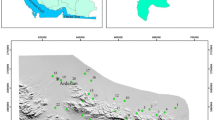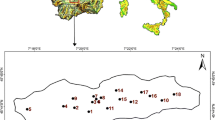Abstract
The present research was carried out to assess the pH, electrical conductivity (EC), dissolved oxygen (DO), and metal concentrations of groundwater in Busan City, Korea. Forty groundwater samples were collected at the environs of major residential and recreational area. The physicochemical parameters (pH, EC, and DO) and metals (Fe, Mn, Cu, Cd and Zn) were analyzed. The metals in groundwater were listed in the descending order of concentration like \(\hbox {Zn}> \hbox {Mn} > \hbox {Cu} > \hbox {Fe} > \hbox {Cd}\). Groundwater pollution indices (heavy metal evaluation index, heavy metal pollution index and degree of contamination) revealed that most of groundwater samples belonged to the low to medium zones. GIS-based spatial maps suggested that the activities of seawater intrusion and salinized river water are pervasive process in this area. Correlation and cluster analyses were used to assess the intensity and source of pollution in groundwater. It was suggested that groundwater quality was polluted mainly by seawater intrusion, infiltration of salinized river water, sewage leaked from sewer, and groundwater discharge from the subway. The pollution status of groundwater systems in this case study are of great environmental and health concerns.





Similar content being viewed by others
References
Akinbile CO, Yusoff MS (2011) Environmental impact of leachate pollution on groundwater supplies in Akure, Nigeria. Int J Environ Sci Dev 2:81–86
APHA (1995) Standard methods for the examination of water and wastewater, 19th edn. American Public Health Association, New York
Astel A, Tsakovski S, Barbieri P, Simeonov V (2007) Comparison of self-organizing maps classification approach with cluster and principal components analysis for large environmental data sets. Water Res 41:4566–4578
Astel A, Tsakovski S, Simeonov V, Reisenhofer E, Piselli S, Barbieri P (2008) Multivariate classification and modeling in surface water pollution estimation. Anal Bioanal Chem 390:1283–1292
Backman B, Bodis D, Lahermo P, Rapant S, Tarvainen T (1997) Application of a groundwater contamination index in Finland and Slovakia. Environ Geol 36:55–64
Bhuiyan MAH, Parvez L, Islam MA, Dampare SB, Suzuki S (2010) Heavy metal pollution of coal mine affected agricultural soils in the northern part of Bangladesh. J. Hazard Mater 173:384–392
Caboi R, Cidu R, Fanfani L, Lattanzi P, Zuddas P (1999) Environmental mineralogy and geochemistry of the abandoned Pb–Zn Montevecchio-Ingurtosu mining district, Sardinia, Italy. Chron Rech Miniere 534:21–28
Chang TW, Kang PC, Park SH, Hwang SK, Lee DW (1983) The Geological Map of Busan and Gadeog (1:50,000). Korea Inst of Energy Resour, 22 p
Chung SY, Venkatramanan S, Kim TH, Kim DS, Ramkumar T (2014) Influence of hydrogeochemical processes and assessment of suitability for groundwater uses in Busan city. Environment, development and sustainability, Korea. doi:10.1007/s10668-014-9552-7
Edet AE, Offiong OE (2002) Evaluation of water quality pollution indices for heavy metal contamination monitoring. A study case from Akpabuyo-Odukpani area, Lower Cross River Basin (southeastern Nigeria). Geo J 57:295–304
Erondu ES, Nduka EC (1993) A model for determining water quality index (WQI) for the classification of the New Calabar River at Aluer-Port Harcourt, Nigeria. J Environ Stud 44:131–134
Ficklin DJ, Plumee GS, Smith KS, McHugh JB (1992) Geochemical classification of mine drainages and natural drainages in mineralized areas. In: Kharaka YK, Maest AS (eds) Water-rock interaction, vol 7. Balkema, Rotterdam, pp 381–384
Handa BK (1981) An integrated water-quality index for irrigation use. Indian J Agric Sci 51:422–426
Holloway JM, Dahlgren RA, Hansen B, Casey WH (1998) Contribution of bedrock nitrogen to high nitrate concentrations in stream water. Nature 395:785–788
Horton RK (1965) An index system for rating water quality. J Water Pollut Control Fed 37:300–306
Imperato M, Adamo P, Naimo D, Arienzo M, Stanzione D, Violante P (2003) Spatial distribution of heavy metals in urban soils of Naples city (Italy). Environ Pollut 124:247–256
Koterba MT, Wilde FD, Laphan WW (1995) Groundwater data collection protocols and procedures for the national water quality assessment program.collection and documentation of water quality samples and related data. US Geological Survey Open file report, 95–399, p 113.
Krishna AK, Satyanarayanan M, Govil PK (2009) Assessment of heavy metal pollution in water using multivariate statistical techniques in an industrial area: a case study from Patancheru, Medak district, Andhra Pradesh, India. J. Hazard Mater 167:366–373
Lermontov A, Yokoyama L, Lermontov M, Machado MAS (2009) River quality analysis using fuzzy water quality index: Ribeira do Iguape river watershed, Brazil. Ecol Ind 9:1188–1197
Li S, Xu Z, Cheng X, Zhang Q (2008) Dissolved trace elements and heavy metals in the Danjiangkou Reservoir, China. Environ Geol 55:977–983
Li Z, Fang Y, Zeng G, Li J, Zhang Q, Yuan Q, Wang Y, Ye F (2009) Temporal and spatial characteristics of surface water quality by an improved universal pollution index in red soil hilly region of South China: a case study in Liuyanghe River watershed. Environ Geol 58:101–107
Mohan SV, Nithila P, Reddy SJ (1996) Estimation of heavy metal in drinking water and development of heavy metal pollution index. J Environ Sci Health 31:283–289
Nriagu JO (1989) A global assessment of natural sources of atmospheric trace metals. Nature 338:47–49
Nriagu JO (1996) A history of global metal pollution. Science 272: 223–224
Nriagu JO, Pacyna JM (1988) Quantitative assessment of worldwide contamination of air, water and soils by trace-metals. Nature 333:134–139
Palupi K, Sumengen S, Inswiasri S, Agustina L, Nunik SA, Sunarya W, Quraisyn A (1995) River water quality study in the vicinity of Jakarta. Water Sci Technol 39:17–25
Peierls BL, Caraco NF, Pace ML, Cole JJ (1998) Human influence on river nitrogen. Nature 350:386–387
Pekey H, Karaka D, Bakoglu M (2004) Source apportionment of trace metals in surface waters of a polluted stream using multivariate statistical analyses. Mar Pollut Bull 49:809–818
Prasad B, Bose JM (2001) Evaluation of the heavy metal pollution index for surface and spring water near a limestone mining area of the lower Himalayas. Environ Geol 41:183–188
Prasanna MV, Praveena SM, Chidambaram S, Nagarajan R, Elayaraja A (2012) Evaluation of water quality pollution indices for heavy metal contamination monitoring: a case study from Curtin Lake, Miri City, East Malaysia. Environ Earth Sci 67:1987–2001
Reddy SJ (1995) Encyclopedia of environmental pollution and control, vol 1. Environmental media, Karlia.
Shoji H, Yamamota T, Nakakaga N (1966) Factor analysis of stream pollution of the Yodo River system. Air Water Soil Pollut 10: 291–299
Siegel FR (2002) Environmental geochemistry of potentially toxic metals. Springer, Berlin
Simeonova P, Simeonov V (2007) Chemometrics to evaluate the quality of water sources for human consumption. Microchim Acta 156: 315–320
Son CM, Lee SM, Kim YK, Kim SW, Kim HS (1978) The Geological map of Dongrae and Weolnae (1:50,000). Korea Res Inst of Geol and Miner Res
StatSoft (1999) Statistica computer program, version 8. StatSoft, Tulsa, Oklahoma
World Health Organization (WHO) (2004) Guidelines for drinking water quality (3rd edn.) (ISBN: 9241546387). Retrived from http://www.who.int/water_sanitation_health/dwq/guidelines/en/
Zhang W, Feng H, Chang J, Qu J, Xie H, Yu L (2009) Heavy metal contamination in surface sediments of Yangtze River intertidal zone: an assessment from different indexes. Environ Pollut 157:1533–1543
Acknowledgments
This work was supported by the Pukyong National University Research Fund in 2012 (PK-2012-0571).
Author information
Authors and Affiliations
Corresponding author
Rights and permissions
About this article
Cite this article
Venkatramanan, S., Chung, S.Y., Kim, T.H. et al. Assessment and Distribution of Metals Contamination in Groundwater: a Case Study of Busan City, Korea. Water Qual Expo Health 7, 219–225 (2015). https://doi.org/10.1007/s12403-014-0142-6
Received:
Revised:
Accepted:
Published:
Issue Date:
DOI: https://doi.org/10.1007/s12403-014-0142-6




